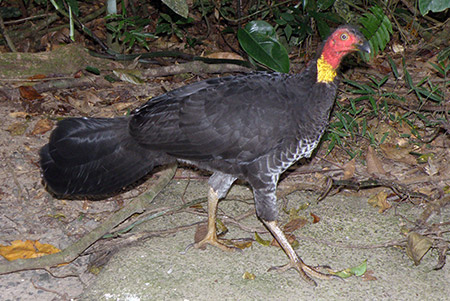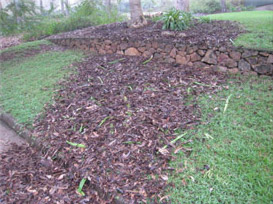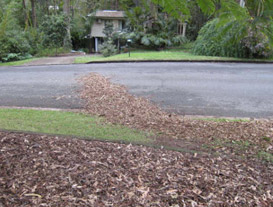Birds
Turkey removal and management
Brush Turkey
Alectura lathami
Other Common names: Bush Turkey, Scrub Turkey, Wild Turkey
Physical description:
Brush Turkeys are robust, dark brownish-black birds growing to an average size of 60-70cm body length.
- Small head & long neck are bare-skinned & reddish in colouring.
- Sexes are easily distinguished: males have a redder head & neck and a distinguishing yellow wattle especially during breeding season; females are more drab and have no wattle.
Ecology
- Principle habitat preference is closed canopy habitat such as rainforest, wet sclerophyll forest and the immediate adjacent environs, but also inhabits dense scrub or moist gullies within dry woodland, through to suburban backyards.
- It is omnivorous but the staple diet consists of forest fruits and small invertebrates.
- Interestingly enough it is currently listed as possibly endangered by some authorities due to habitat destruction in the south of its range in NSW. Here in Queensland it is a well established component of the suburban ecology.
Breeding & Mounding
- Breeding occurs from August through to December or January.
- Nest material consists of a terrestrial mound of decomposing vegetation, leaf litter and soil from 2m up to 4-6 m wide and 1-1.5m high.
- Mound is essentially a compost heap that is maintained at a steady temperature of 32-33degC for the duration of the nesting season. Temperature is regulated by subtracting or adding decomposing material.
- Males defend their nest & territory around it from other males.
- Many females may be lured to a single nest by an amorous male, each capable of depositing up to 24 eggs in a season.
- Subsequently one mound may contain up to 150 eggs over a season. Incubation is approximately 50 days.
- Eggs vary in size but are generally larger than a chicken egg (approx-90mm x 65mm), and chalky white, becoming stained & mottled yellowish-brown during incubation.
- Newly hatched young resemble quail with huge legs and feet, and amazingly, hatch and dig themselves out of the nest, and are independent and capable of flight within hours of emerging from the egg.
- Chick mortality is high, falling prey to goannas, snakes, birds of prey and domestic cats and dogs. Studies show adult recruitment is as low as 1 in 200
Suburban Turkeys:
- The Brush Turkey is a highly successful occupant of nearly all Brisbane suburbs. Suburbs such as The Gap, West End, Chapel Hill and Kenmore have an extensive overhead tree-canopy with heavy under-storey planting in most yards. In particular these suburbs have high densities of turkeys.
- Favorable conditions provided by this tree-canopy and high available feeding resources replicate their preferred closed forest habitat. This has changed the micro-climate of otherwise “turkey-unfriendly suburbs” into turkey utopia.
- Other activities that assist turkeys include hand feeding by residents, feeding domestic pets outside, and the wildlife corridors and natural gullies that are prevalent in hilly suburbs such as those previously mentioned.
- Areas that could naturally only house single birds can now have higher occupancy due to high availability of food, suitable habitats and refuges.
- Males are thus flat-out keeping up with the high number of available females in a small zone around their mound, enabling more males to successfully establish active mounds in closer proximityThe end result is higher fecundity, or reproductive success, and therefore more adult recruitment.
- During the breeding season (Aug to Dec), male brush turkeys can reduce bush gardens to composting piles as they endeavour to make their nest. Small plants and even irrigation systems are common casualties of this behaviour.
Living with Brush-turkeys

Mornings work for a determined turkey
The sight of your backyard bush-landscape being converted into an unattractive pile of decomposing compost matter is enough to infuriate any proud home owner. With his powerful legs and insatiable desire to mound and breed, the suburban backyard is no match for these industrious birds. A single male is capable of raking material into the mound from not only yours, but also surrounding neighbours’ yards, when required.
So what can you do to try and deter an industrious turkey in your yard prior to engaging turkey removal?
- Firstly the Brush Turkey is protected within Queensland and attempts to harm the bird or trap it without the appropriate permit are illegal. Although often frustrating to live with at times, these birds are merely taking advantage of the suitable conditions you have provided through your constructed garden landscape.
- Remember, the Brush Turkey favours moist gardens with a combination of intermittent shade, tree litter & mulch, and available food resources, which facilitates both foraging and nesting behaviour.
- Don’t waste time trying to destroy a mound or chase the bird away. This will only result in further frustration and will have no long term effect.
- If it is only just established, cover the mound with a heavy duty tarpaulin or shade cloth. This may encourage the bird to change location.
- Never feed turkeys. Any food source may encourage the bird to remain nearby. This also includes leaving food available for other native species & household pets. Keep piles of spare mulch, leaf litter & compost covered with tarpaulins.
- Communicate with your neighbours as the bird may also be affecting them

A day later after yesterdays clean up
Garden Design & Pre-planning
- When planning your garden consider the use of rock combined with heavy planting. Species such as Lomandra, Dietes, Bromeliad, and some low growing Grevillea varieties can be planted en-masse and provide thick ground cover.
- A layer of diamond-wire or chicken-wire below the surface of your mulch will discourage or make it difficult for the Turkey to rake the ground.
- Use tree guards around small or newly-established plants for protection.
- Heavy covering such as larger-size river gravel may be incorporated around the base of trees & plants to protect from root disturbance.
Advice & Relocation
If your best efforts of deterring the bird fail then further advice or relocation may be your last resort. Ecologically-minded turkey advice, specialist trapping requirements, and ecologically sound translocation methods are employed by licensed professionals for effective turkey relocation.
Contact – your local Brush Turkey specialist.
Turkey removal is done in accordance with requirements stipulated by the Department of Environment and Science and permits are issued after stringent examination as to knowledge and suitability to actively manage conflict turkeys and provide turkey removal services. Turkey removal should only be conducted by a permitted and knowledgeable person as incorrect methods can lead to the death of animals.
Every effort is made to ensure the birds are managed as to welfare, and to minimize any possible harm whilst being trapped, upon trapping, and through transit to a suitable release site.
Sites for release are selected prior to inspection as to their suitability for turkey habitat.
Turkey removal contacts for Brisbane, Gold Coast and surrounding areas can be reached for the following areas:
Brisbane West including The Gap, Bardon, Chapel Hill, Kenmore, Brookfield, Sinnamon Park Oxley, Algester, Forestdale and surrounding suburbs
0413 028 081
Ipswich and surrounding suburbs
0413 028 081
Brisbane North, including Moreton Bay Regional council areas south of Caboolture
0413 028 081
Brisbane South including Moorooka, Yeronga, Woolloongabba, Wynnum, Cleveland, Carindale, Holland Park, Marsden
0421 455 077
Gold Coast all suburbs
0418 738 228
